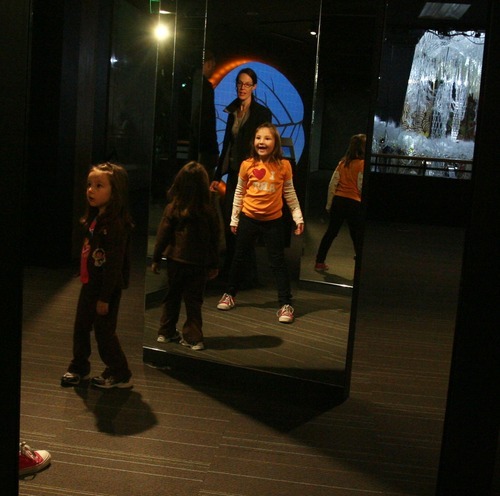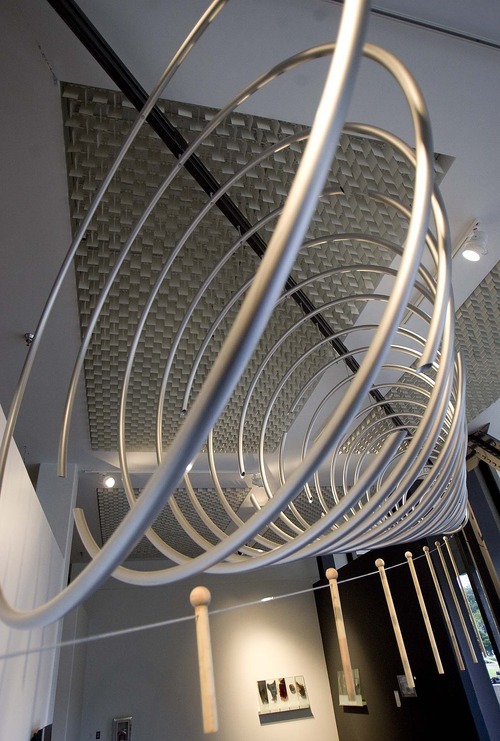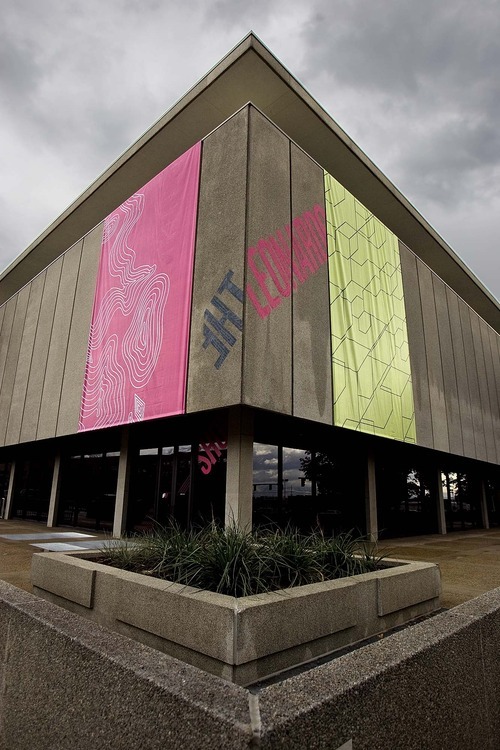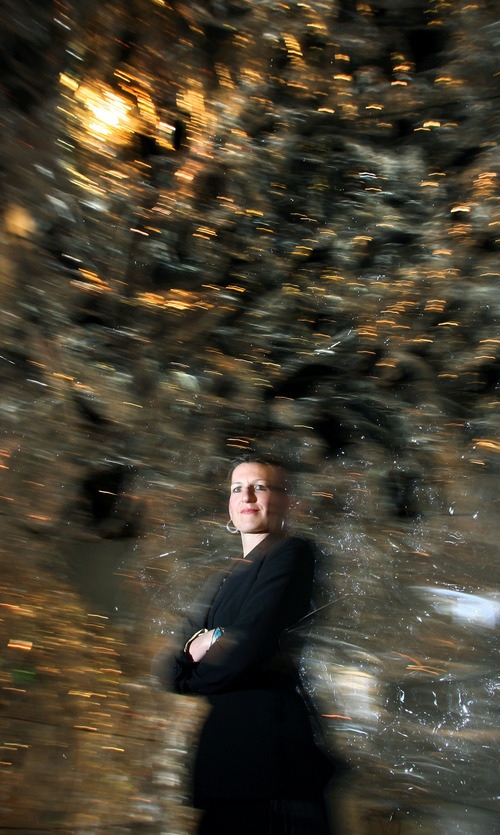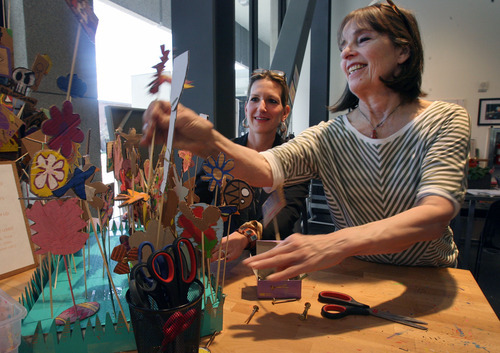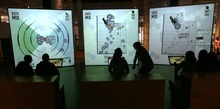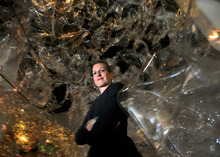This is an archived article that was published on sltrib.com in 2012, and information in the article may be outdated. It is provided only for personal research purposes and may not be reprinted.
The Leonardo, the new Salt Lake City museum, prides itself on teaching critical thinking, innovation and creativity, yet finds itself under examination on a very public microscope slide.
After six months, The Leonardo continues to struggle to attract visitors in large numbers, in part because it hasn't defined exactly what it offers. The museum has drawn 40,000 visitors since it opened Oct. 9. That's in contrast to the Natural History Museum of Utah, which opened a new building a month after The Leonardo and has drawn 151,000 visitors.
Attendance revenue is only part of the complex calculus behind a museum's support, but visitors lead to private donations, corporate sponsorships and taxpayer support that The Leonardo desperately needs.
The museum has gotten on track after adjusting downward its initial projections, says Executive Director Alexandra Hesse, who replaced Peter Giles, who returned to retirement after the museum's opening.
Hesse terms this "calibrating to reality." "So now we are getting what we counted on — that's the important thing," Hesse says. "The business plan was written a couple of years ago, but after opening we made adjustments. That's a normal process."
She adds: "When we opened, it wasn't a finish line, but the starting point."
In these early months, The Leonardo has suffered from so-called branding issues: Is it a science museum, an art gallery or a technology showplace? Is it for kids or adults?
Yet Hesse says the museum is addressing these concerns by reorganizing its management staff, including hiring vice presidents for marketing and programming.
—
But what is it? • When The Leonardo (casually referred to as The Leo) opened in October, it already had survived a rocky embryonic period. Salt Lake City residents had approved a $1.2 million bond to pay for the renovation of the old downtown Main Library to house the museum, but the funds were temporarily blocked by Mayor Ralph Becker and the City Council. The mayor expressed reservations about The Leo's overly ambitious business plan, which didn't seem sustainable.
After a forced management shake-up, The Leo opened nearly six months behind schedule, in time to be overshadowed a month later by the premiere of the well-funded and deeply established Natural History Museum of Utah. By its opening, The Leonardo had been forced to borrow $600,000 from the city to cover operating costs during the six-month delay. In addition, during its recent session, the Utah Legislature gave the museum a $200,000 grant.
Despite that financial support, The Leo's concept has been difficult for potential visitors to understand. It's not a children's museum or simply a science museum, nor is it an art gallery, though contemporary art is an important part of its identity.
Supporters argue that visitors should just look to its namesake, Leonardo da Vinci, a Renaissance genius who saw no boundaries between science, art, design, invention and architecture, whether it be painting the Mona Lisa or inventing a helicopter prototype 500 years before its time.
But some early visitors were unprepared for what they saw: Exhibits spotlighting high-tech prosthetic limb development and genetics research share space with sprawling contemporary art sculptures.
—
The art of algae • Hesse says the museum staff has made adjustments to help visitors overcome such initial bafflement.
Now staffers patrol the floor and help guide and explain exhibits to anyone with a perplexed expression. Staff members also roll out demonstration carts, loaded with hands-on materials and simple experiments to involve visitors, especially children.
The recently unveiled 4,000-square-foot artwork "Holotype" by Utah artist Amy Caron is a case in point. The sprawling plastic sheeting-rebar-and-dirt exhibit winds through most of the museum's east wing. The Leo commissioned "Holotype" for $155,000 for a 12-month run. The work is based on Caron's creative take on algae, one of the most prevalent life forms and a potential source of energy.
Unfortunately, many visitors simply didn't get "Holotype," let alone its connection to algae.
"We felt like we had to help visitors to interpret the piece," Hesse says. "We have added a demo cart with hands-on and more explanatory material. Sometimes, that is all it takes to get people to stop and look, because if you are not used to installation art in a context like this, you might walk through and say, 'I don't even know what this is.' "
A permanent biometric sculptural work, "Hylozoic Veil," by Canadian architect Philip Beesley, who has installed similar exhibits in cities around the world, has been better received. With a little explanation, visitors seem mesmerized by the feathery and seemingly living colony of sensors, vials and artificial muscles that ripples overhead.
For the staff, Beesley's $750,000 work has come to serve as a metaphor for The Leonardo — a combination of science and technological innovation that isn't afraid to be beautiful.
"That's exactly what we are building the museum on," Hesse says. "It's getting our visitors, no matter what their age, to open their eyes and be curious about the world and begin this journey of discovery. How to put that in a few words, I admit, it isn't easy."
—
A community of curiosity • Supporters of The Leonardo maintain it was never meant to be a traditional look-and-see museum. The Leo aims to enlist a community of creative adults and teens who will be challenged and inspired by the exhibits.
In fact, Hesse says that membership, not one-time admission tickets, is what the museum emphasizes. Members are offered special panel discussions on exhibits at the museum, events that will allow them to socialize and exchange insights with other members and, Hesse hopes, return again and again.
Leo board member and venture capitalist Dinesh Patel, managing partner at vSpring Capital, thinks the concept, perhaps belatedly, is taking root.
"Based on the people who have visited it that I've talked to, it certainly seems like they are beginning to get the idea of combining the various forms — visual arts, technology, science," Patel says. "I think it's beginning to take hold."
Patel takes an entrepreneur's view, which might not comfort those who oversee public money. "It may take a year or so, like any startup," he says. "It always takes longer and more money than you anticipated."
Fred Lampropoulos, an inventor and chief executive of Merit Medical, has supported The Leo financially from the beginning, seeing it as an "economic development tool."
"Technology moves on with or without you," he says. "If your children are going to be thinking about ideas — this is one place to get them. Where else do they see the application of technology?"
Lampropoulos says he takes his staff to the museum to stimulate creative thinking. Other museums in the state don't do that, he says. "The exhibits at the Museum of Natural History are extraordinary. But I don't know how much of that is going to provide a job for someone in the future."
—
An idea before its time? • Ticket sticker shock has been another problem for the museum, acknowledged Lampropoulos, Patel and others. Admission ranges from $14 for an individual to $40 for a family of four. (The Natural History Museum charges $9 for adults and $6-$7 for children.)
"There were a bunch of operational issues that needed to be looked into," Patel says. "That $14 price seems to be high for a lot of people," Patel says. "That's another thing [Leonardo managers] are evaluating right now."
Lampropoulos says Leo management assures him they are working on innovative ways to overcome the high admission, including offering scholarships, $7 Wednesdays and partnering with businesses and other cultural entities. (A joint admission scheme with the Natural History Museum has been discussed, but no deal has been struck.)
And Hesse is counting on the museum's new marketing czar to clarify the branding problem. "We are a completely new model, and part of the confusion comes from the fact that there isn't one word that describes what we are," she says. "It's definitely a challenge to communicate something new."
The staff additions, she says, won't require additional money. "We have rejiggered — put people in different places."
Still, getting The Leo's message out through advertising would be expensive for a museum that has been — as Lampropoulos puts it—"boot-strapping it" since the beginning
Patel says The Leonardo may simply be ahead of the curve. "Utah is at the cutting edge, and we need a cutting-edge museum. I would rather be early than late."
Of course, being too early runs the risk of failure, Lampropoulos acknowledges. "Like anything else, you have to fight the battle. Many businesses have great ideas but they don't have enough cash flow to survive."
Twitter: @gwarchol
facebook.com/nowsaltlake —
The Leonardo
Where • 209 E. 500 South, on Library Square, Salt Lake City
Hours • Closed Monday and Tuesday; Wednesday and Thursday 11 a.m.-7 p.m.; Friday 11 a.m.-10 p.m; Saturday 11 a.m.-7 p.m.; Sunday 11 a.m.-5 p.m.
Admission • $14; seniors, $12; age 6-17 and students, $10; age 5 and younger, free; family of four, $40 (additional person $7); Wednesdays, $7.
Info • http://www.theleonardo.org
Also • The museum will celebrate its namesake Leonardo de Vinci's 560th birthday with a variety of events April 13-15, including a museum treasure hunt and workshops to create kinetic machines, practice backward writing and create animated short films, as well as a Jump in the Motion capture booth and the opportunity to play with models of the artist's inventions.
Also • On Saturday, April 14, the museum will hold a lab with MIT roboticist Jeff Lieberman. On Sunday, April 15, there will be presentations of "Discovering da Vinci" at noon and 3 p.m. —
Monthly attendance at Utah museums
Museums appeal to different audiences, which make attendance comparisons complicated. That's even more so with Salt Lake City's The Leonardo, due to its boundary-crossing concept that bridges art, science and technology.
7,000 • The Leonardo
38,00 • Utah Museum of Natural History
8,500 • Utah Museum of Contemporary Art (formerly known as the Salt Lake Art Center)
11,300 • Utah Museum of Fine Arts


